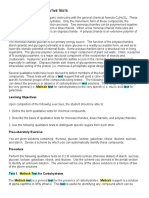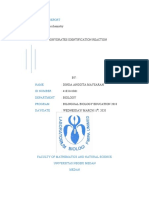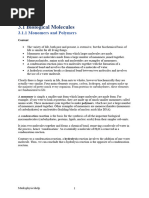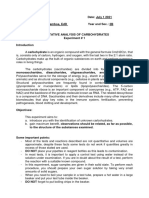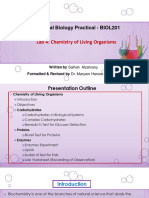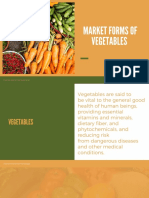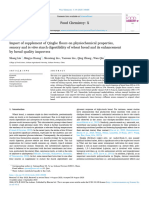MC2 Experiment No 2
MC2 Experiment No 2
Uploaded by
maicadicionCopyright:
Available Formats
MC2 Experiment No 2
MC2 Experiment No 2
Uploaded by
maicadicionOriginal Description:
Original Title
Copyright
Available Formats
Share this document
Did you find this document useful?
Is this content inappropriate?
Copyright:
Available Formats
MC2 Experiment No 2
MC2 Experiment No 2
Uploaded by
maicadicionCopyright:
Available Formats
Experiment Title: Carbohydrates Materials:
Experiment Objectives: At the end of the experiment, Laboratory Manual
students are expected to: References:
1. identify common carbohydrates in nature; Bettelheim, Frederick., et., al.
2. classify the different carbohydrates and; (2010) Laboratory Experiments
for Introduction to General,
3. perform simple qualitative tests for carbohydrates. Organic, and Biochemistry, 7th
ed., ISBN-13: 978-0-495-
39196-8
Voet, Donald., et., al. (2008)
Fundamentals of
Biochemistry: LIFE AT THE
MOLECULAR LEVEL, 2nd ed.,
ISBN-13 978-0470-12930-2.
Productivity Tip:
Isolate yourself from distractions!
Introduction
Carbohydrates are most abundant organic compounds found in living organisms and are
composed of carbon, hydrogen and oxygen. Carbohydrates act as the primary source to provide
energy for functioning of living organisms. These are called carbohydrates because they can be
considered as hydrates of carbon. Carbohydrates, or saccharides, are divided into
monosaccharides, disaccharides, and polysaccharides.
A monosaccharide consists of a single carbohydrate molecule, containing between 3 and
7 carbons. Glucose and fructose are examples of monosaccharides. A disaccharide consists of
two monosaccharides that are linked together. Sucrose and lactose are disaccharides. A
polysaccharide consists of many monosaccharides linked together. Starch, pectin, glycogen, and
cellulose are examples of polysaccharides.
PRE-LABORATORY ACTIVITY
A. Answer the following questions
1. What is carbohydrates? What is the structural characteristic of carbohydrates?
2. How are carbohydrates classified? Give examples for each classification.
3. Discuss the principles behind each of the following test.
a) Fehling’s test
b) Seliwanoff’s test
c) Iodine test
4. What are reducing sugars? Why is sucrose non-reducing while lactose also a
disaccharide, is reducing? Why are monosaccharides reducing sugars?
5. How do starch and glycogen differ structurally?
Materials/Reagents
▪ Test tubes (9 pcs) ▪ Test tube rack (1 pc)
MC2, Biochemistry Laboratory
▪ Test tube brush (1 pc) ▪ Glucose
▪ Beaker (1 pc 500 ml for boiling) ▪ Maltose
▪ Test tube holder (1 pc) ▪ Lactose
▪ Pipette (4 pcs, 1 ml) ▪ Fructose
▪ Aspirator (1 pc) ▪ Galactose
▪ Fehlings A&B ▪ Sucrose
▪ Seliwanoff’s Reagent ▪ Starch
▪ I2KI solution ▪ Distilled water
▪ Arabinose
Procedure
A. General Tests
Fehling’s Test
General Principle: Fehling's test is an indicating reaction for reducing groups like Aldehyde
functions. The principle of this test is based on the fact that the aldehyde group of sugar is oxidized
to form acids by complex Copper ions. The Red Copper (I) oxide then precipitates.
Procedure:
1. In nine labeled test tube, place 2 ml of the following:
Test tube No. Sugar Solutions
1 5% fructose
2 5% galactose
3 5% arabinose
4 5% glucose
5 5% maltose
6 5% sucrose
7 5% lactose
8 5% starch
9 water
2. Add 1 ml of Fehling's solution A and Fehling's solution B to it.
3. Place the solution in a boiling water bath for about 10 minutes. Observe
*The formation of red precipitate indicates the presence of carbohydrate.
B. Specific Test for some Carbohydrates
Seliwanoff’s Test – Resorcinol – HCL Test (Test for Ketoses)
Principle: Ketoses, particularly fructose, form hydroxymethyl furfural by the action of HCL and
condenses with resorcinol to form a red color.
Procedure:
1. In nine labeled test tube, place 1 ml of the following:
Test tube No. Sugar Solutions
1 5% fructose
2 5% galactose
3 5% arabinose
4 5% glucose
5 5% maltose
6 5% sucrose
7 5% lactose
8 5% starch
9 water
2. Add 2 ml of Seliwanoff’s reagent in a labelled test tube, mix and heat the mixture to boiling for
10 minutes.
3. Observe
MC2, Biochemistry Laboratory
*The appearance of cherry red color with or without the separation of a brown – red precipitate
indicates the presence of a ketose.
Note: the time of appearance of s red color.
Aldoses, like glucose, may give a positive reaction upon prolonged heating. This is due to catalytic
transformation of glucose to fructose by HCL.
Iodine test
General principle: The basic principle involved in the iodine test is that Amylose interacts with starch
to form a blue-black colored complex with the iodine. The helical structure of Amylose forms a
charge transfer (CT) complex with iodine, wherein iodine is present inside the spiral or helical
structure of the Amylose.
Procedure:
1. In nine labeled test tube, place 1 ml of the following:
Test tube No. Sugar Solutions
1 5% fructose
2 5% galactose
3 5% arabinose
4 5% glucose
5 5% maltose
6 5% sucrose
7 5% lactose
8 5% starch
9 water
2. Pipette 1 ml of 0.1 M I2KI solution and Add to the solution.
3. observe for a change in color from reddish brown to blue.
MC2, Biochemistry Laboratory
You might also like
- Isolation and Characterization of CarbohydratesDocument4 pagesIsolation and Characterization of CarbohydratesNadz Gonzalez100% (3)
- Carbohydrate Qualitative AnalysisDocument9 pagesCarbohydrate Qualitative AnalysisRamesh KandagatlaNo ratings yet
- Enrichment of Lithium in Lettuce Plants Through Agronomic BiofortificationDocument13 pagesEnrichment of Lithium in Lettuce Plants Through Agronomic BiofortificationAL DONo ratings yet
- Biochemistry Manual PDFDocument99 pagesBiochemistry Manual PDFSri KanthNo ratings yet
- BIOCHEM MANUAL Carbohydrates and LipidsDocument18 pagesBIOCHEM MANUAL Carbohydrates and Lipidssophialucero3245No ratings yet
- Experiment 5Document9 pagesExperiment 5Ames Morales TorresNo ratings yet
- Biochem 2019 Metab-And-UrineDocument17 pagesBiochem 2019 Metab-And-UrineRMNo ratings yet
- Molisch and Iodine TestDocument29 pagesMolisch and Iodine TestTom Anthony Tonguia20% (5)
- Exp. 3 Test For The Presence of Carbohydrates Molisch Test 1Document4 pagesExp. 3 Test For The Presence of Carbohydrates Molisch Test 1cristine lomoljo100% (1)
- (Bio 024) Biochemistry Lab Activity 9 Test For CarbohydratesDocument4 pages(Bio 024) Biochemistry Lab Activity 9 Test For CarbohydratesAnandu Raj0% (1)
- Isolation and Characterization of CarbohydratesDocument4 pagesIsolation and Characterization of CarbohydratesJearweine FormaranNo ratings yet
- Starch Hydrolysis by AmylaseDocument9 pagesStarch Hydrolysis by Amylasegaurav saxenaNo ratings yet
- Group 6 - Experiment 1 (Qualitative Analysis Test For Carbohydrates)Document11 pagesGroup 6 - Experiment 1 (Qualitative Analysis Test For Carbohydrates)Neki MandaweNo ratings yet
- Biochemistry I ManualDocument16 pagesBiochemistry I ManualKelz mangNo ratings yet
- BCM 202Document49 pagesBCM 202Naufal QaweimNo ratings yet
- Qualitative Test for CarbohydratesDocument8 pagesQualitative Test for Carbohydrates13 Madhur SharmaNo ratings yet
- CARBOHYDRATES Qualitative TestsDocument3 pagesCARBOHYDRATES Qualitative TestsEdith BelenNo ratings yet
- Paper 1 AsDocument156 pagesPaper 1 As18salawadNo ratings yet
- EXP2 BIOCHEM Analyzing and Determine Sugars and Starch in Plant Tissues.Document10 pagesEXP2 BIOCHEM Analyzing and Determine Sugars and Starch in Plant Tissues.NUR AMALIA BINTI MAZLEE STUDENTNo ratings yet
- DINDA - Biochem Pract ReportDocument18 pagesDINDA - Biochem Pract ReportdindaNo ratings yet
- 2 - Denaturation of ProteinDocument3 pages2 - Denaturation of ProteinnotshiroNo ratings yet
- Exp 2-Starch Hydrolysis by AmylaseDocument6 pagesExp 2-Starch Hydrolysis by AmylaseGintoki SakataNo ratings yet
- Exp 2-Starch Hydrolysis by AmylaseDocument6 pagesExp 2-Starch Hydrolysis by AmylaseDodi Ihsan TaufiqNo ratings yet
- Experiment 4 GRP 14Document12 pagesExperiment 4 GRP 14spencermverasNo ratings yet
- 3.1 Biological Molecules: 3.1.1 Monomers and PolymersDocument28 pages3.1 Biological Molecules: 3.1.1 Monomers and Polymersleonb070707No ratings yet
- Lab 2Document9 pagesLab 2Elizalde Husband100% (1)
- Carbohydrates Estimation Teaching Kit (Qualitative)Document9 pagesCarbohydrates Estimation Teaching Kit (Qualitative)Shirmayne TangNo ratings yet
- Lipid MetabolismDocument9 pagesLipid MetabolismDianaMamaligaNo ratings yet
- Isolation, General Tests, and Hydrolysis of Polysaccharides Formal ReportDocument4 pagesIsolation, General Tests, and Hydrolysis of Polysaccharides Formal ReportJuliefer May Fanilag Pleños100% (1)
- Exercise 8. Analysis of CarbohydratesDocument3 pagesExercise 8. Analysis of CarbohydratesAte MerlsNo ratings yet
- Carbo HayDocument8 pagesCarbo HaymaicadicionNo ratings yet
- 112 2024 Lab 2Document10 pages112 2024 Lab 2thomas.vignerasNo ratings yet
- Experiment 4Document13 pagesExperiment 4Iqmal HafidzNo ratings yet
- UntitledDocument8 pagesUntitledIvy ManagNo ratings yet
- Act 3 Carbohydrates Revised 01.2024 - Edited 4Document12 pagesAct 3 Carbohydrates Revised 01.2024 - Edited 4Raisa PailanNo ratings yet
- Exercise 4 Coagulation and Denaturation of Protein: ObjectiveDocument4 pagesExercise 4 Coagulation and Denaturation of Protein: ObjectiveStephanie Abler AbellanosaNo ratings yet
- Fecal Coliform TestDocument11 pagesFecal Coliform Test22je1042No ratings yet
- Experiment 6 - Characterization of CarbohydratesDocument7 pagesExperiment 6 - Characterization of CarbohydratesppgzcwsyrjNo ratings yet
- Lab Report MicrobiologyDocument11 pagesLab Report Microbiologysalman ahmedNo ratings yet
- Formal Report - CarbohydratesDocument4 pagesFormal Report - Carbohydratesfefebelmonte100% (2)
- Laboratory Activity No. 2 - Analysis of Carbohydrates - 1Document4 pagesLaboratory Activity No. 2 - Analysis of Carbohydrates - 1Juliane JaynNo ratings yet
- Chem 415 Experiment 1Document6 pagesChem 415 Experiment 1ttussenoNo ratings yet
- General Biology Practical - BIOL201: Lab 4: Chemistry of Living OrganismsDocument29 pagesGeneral Biology Practical - BIOL201: Lab 4: Chemistry of Living Organismsmojada188No ratings yet
- Expt. 1 Qualitative Analysis Test For CarbohydratesDocument8 pagesExpt. 1 Qualitative Analysis Test For CarbohydratesMary Ella Mae PilaNo ratings yet
- UNIT4 Expt1Document6 pagesUNIT4 Expt1Christian Franco RuizNo ratings yet
- Experiment 4 - Theory and ProtocolDocument6 pagesExperiment 4 - Theory and ProtocolShahad AlAliNo ratings yet
- Bioquímica: Un Estudio Práctico de Las BiomoléculasDocument60 pagesBioquímica: Un Estudio Práctico de Las Biomoléculasarmando gutierrezNo ratings yet
- Isolation and Characterization of CarbohydratesDocument5 pagesIsolation and Characterization of CarbohydratesSunshine VendivilNo ratings yet
- Exp 1 PhysioDocument22 pagesExp 1 Physiogargi4a16No ratings yet
- Written Report CarbohydratesDocument10 pagesWritten Report CarbohydratesRoxanne Jane BirondoNo ratings yet
- Science10 Chemistry Module3 2023-2024Document17 pagesScience10 Chemistry Module3 2023-2024mjmabini047100% (1)
- Iodine TestDocument3 pagesIodine TestRahaf AljboriNo ratings yet
- betlogDocument7 pagesbetlogBARTULING tvNo ratings yet
- Lab ReportDocument6 pagesLab Reportapi-276904981No ratings yet
- Qualitative Analysis of Carbohydrates ExperimentDocument12 pagesQualitative Analysis of Carbohydrates Experimentasdf65365254750% (2)
- 4 Activity Carbohydrates IIDocument9 pages4 Activity Carbohydrates IIFelica Delos ReyesNo ratings yet
- Food BiochemistryDocument10 pagesFood BiochemistrySaima RiazNo ratings yet
- 10 CarbohydratesDocument6 pages10 CarbohydratesBryanNo ratings yet
- U3 & 6 ExperimentsDocument36 pagesU3 & 6 Experimentsmedaaaf1No ratings yet
- Plant and Animal Bio-Chemistry - Including Information on Amino Acids, Proteins, Pigments and Other Chemical Constituents of Organic MatterFrom EverandPlant and Animal Bio-Chemistry - Including Information on Amino Acids, Proteins, Pigments and Other Chemical Constituents of Organic MatterNo ratings yet
- The Total Synthesis of Natural ProductsFrom EverandThe Total Synthesis of Natural ProductsJohn ApSimonNo ratings yet
- Best Supplements and Vitamins For AutismDocument9 pagesBest Supplements and Vitamins For AutismjohnnyparabellumNo ratings yet
- Almarai Company SWOT AnalysisDocument12 pagesAlmarai Company SWOT AnalysisJacques OwokelNo ratings yet
- Home Management and Family EconomicsDocument15 pagesHome Management and Family EconomicsRichard Empimo100% (1)
- Flaxseed PDFDocument2 pagesFlaxseed PDFVimal RathinasamyNo ratings yet
- Tugas Bikin MediaDocument12 pagesTugas Bikin MediaWa FfaNo ratings yet
- Market Forms of VegetablesDocument22 pagesMarket Forms of VegetablesMay Ann GuintoNo ratings yet
- FY8E Healthy Living Detailed SolutionDocument18 pagesFY8E Healthy Living Detailed Solutionlycanderek08No ratings yet
- 2021 Pigeon Product CatalogueDocument7 pages2021 Pigeon Product CatalogueMiss BooksNo ratings yet
- 07 List of TablesDocument3 pages07 List of TablesCOMMERCE TVNo ratings yet
- Importancia Del Cromo en Ganado LecheroDocument24 pagesImportancia Del Cromo en Ganado LecheroGerardoNo ratings yet
- Standard Portion Cost (Objectives & Cost Cards) - Production ControlDocument2 pagesStandard Portion Cost (Objectives & Cost Cards) - Production Controlshamlee ramtekeNo ratings yet
- Edp Final ProjectDocument27 pagesEdp Final ProjectAyush AnjanaNo ratings yet
- Sesion 5 InglesDocument14 pagesSesion 5 InglesIrma Lujan PauccaNo ratings yet
- 2023 - LIN - Impact of Supplement of Qingke Flours On Properties and in Vitro Digestibility of Wheat Bread...Document10 pages2023 - LIN - Impact of Supplement of Qingke Flours On Properties and in Vitro Digestibility of Wheat Bread...TatianaNo ratings yet
- LC-MS/MS For The Determination of Four Water Soluble Vitamins: Method Development, Validation and Comparison To EC MethodDocument6 pagesLC-MS/MS For The Determination of Four Water Soluble Vitamins: Method Development, Validation and Comparison To EC MethoddewiNo ratings yet
- Edexcel IGCSE Biology Specification Questions Part 2 Section 1Document53 pagesEdexcel IGCSE Biology Specification Questions Part 2 Section 1ZoonieFRNo ratings yet
- 19 French Knife Cuts - Top Chef Chopping Terms Snippets of ParisDocument18 pages19 French Knife Cuts - Top Chef Chopping Terms Snippets of ParisRochelle RuizNo ratings yet
- Nutrients: Eating Habits and Lifestyle During COVID-19 Lockdown in The United Arab Emirates: A Cross-Sectional StudyDocument20 pagesNutrients: Eating Habits and Lifestyle During COVID-19 Lockdown in The United Arab Emirates: A Cross-Sectional StudynurulaqilahizzatiNo ratings yet
- Breakfast Around The WorldDocument7 pagesBreakfast Around The WorldLaura noguesNo ratings yet
- Carbon, Hydrogen and Oxygen: 1. CarbohydratesDocument9 pagesCarbon, Hydrogen and Oxygen: 1. CarbohydratesRusya YahayaNo ratings yet
- Cardoso 2022Document18 pagesCardoso 2022Bruno FreireNo ratings yet
- Spelling and Pronunciation - CurrentDocument4 pagesSpelling and Pronunciation - CurrentOsama NazmyNo ratings yet
- Product Approval Lists 03-11-2022Document42 pagesProduct Approval Lists 03-11-2022gmanthesh12No ratings yet
- Quiari Product BrochureDocument7 pagesQuiari Product BrochureSk MinajulNo ratings yet
- Bai Thuyet Trinh Thi Cuoi HKDocument3 pagesBai Thuyet Trinh Thi Cuoi HKlee hoangNo ratings yet
- Agricultural Science Broiler CAPE IADocument28 pagesAgricultural Science Broiler CAPE IALehanna JohnsonNo ratings yet
- Easy 300 Calorie Cookbook - Maggie ChowDocument178 pagesEasy 300 Calorie Cookbook - Maggie ChowJade100% (2)
- Ch.3 Food, Nutrition, Health & FitnessDocument14 pagesCh.3 Food, Nutrition, Health & FitnessSimar SinghNo ratings yet
- Asupan Protein, Kalsium Dan Fosfor Pada Anak Stunting Dan TidakDocument8 pagesAsupan Protein, Kalsium Dan Fosfor Pada Anak Stunting Dan TidakAgeng betaNo ratings yet
















